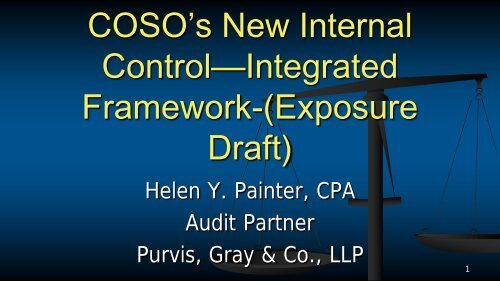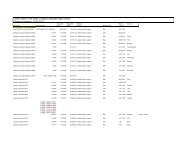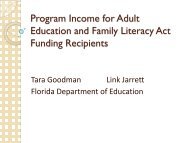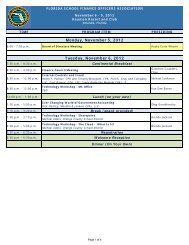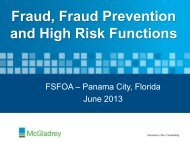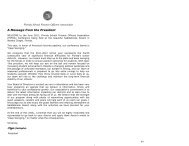Internal Controls and Fraud
Internal Controls and Fraud
Internal Controls and Fraud
You also want an ePaper? Increase the reach of your titles
YUMPU automatically turns print PDFs into web optimized ePapers that Google loves.
COSO’s New <strong>Internal</strong><br />
Control—Integrated<br />
Framework-(Exposure<br />
Draft)<br />
Helen Y. Painter, CPA<br />
Audit Partner<br />
Purvis, Gray & Co., LLP<br />
1
What is the Status?<br />
• Exposure Draft Stage<br />
• Comments Due November 16, 2012<br />
• Written comments will be available on-line March 31, 2013<br />
• www.ic.coso.org<br />
• Framework <strong>and</strong> Appendices<br />
• IC over External Financial Reporting: A Compendium of<br />
Approaches <strong>and</strong> Examples<br />
• Illustrative Tools for Assessing Effectiveness of a System of<br />
<strong>Internal</strong> Control<br />
• Executive Summary & Feedback Questions<br />
2
Do You Remember COSO?<br />
• Committee of Sponsoring Organizations of the<br />
Treadway Commission (COSO)<br />
• 1992 released the original framework<br />
• Gained Broad Acceptance<br />
• Leading framework for<br />
• Designing<br />
• Implementing<br />
• Conducting internal control<br />
• Assessing the effectiveness of internal Control<br />
3
Twenty Years Latter<br />
• Business <strong>and</strong> Organizational Changes<br />
• Technology<br />
• Complex Transactions<br />
• Global<br />
• Stakeholders-Want More Assurance<br />
• Taxpayers<br />
• Shareholders<br />
• Owners<br />
4
Mission of COSO<br />
Dedicated to providing thought leadership<br />
through the development of<br />
comprehensive frameworks <strong>and</strong> guidance<br />
on internal control, enterprise risk<br />
management, <strong>and</strong> fraud deterrence<br />
designed to improve organizational<br />
performance <strong>and</strong> oversight <strong>and</strong> to reduce<br />
the extent of fraud in organizations.<br />
5
Updated COSO Cube<br />
7
Help For External Stakeholders<br />
• Greater confidence in the Board’s Oversight of<br />
IC<br />
• Greater confidence in achieving Entity’s goals<br />
• Greater confidence to identify risks<br />
• Greater underst<strong>and</strong>ing of the requirement of<br />
effective system of IC<br />
• Greater underst<strong>and</strong>ing that management can<br />
eliminate ineffective or redundant controls<br />
8
COSO’s Structure<br />
• Private Sector Initiative<br />
• Sponsored <strong>and</strong> Funded by:<br />
• American Accounting Association<br />
• American Institute of Certified Public Accountants<br />
• Financial Executives International<br />
• Institute of Management Accountants<br />
• The Institute of <strong>Internal</strong> Auditors<br />
9
COSO’s Participants<br />
• Board Members – 8<br />
• Principal Contributors (From PwC) – 9<br />
• Advisory Council – 5<br />
• Members at Large – 9<br />
• Regulatory Observers <strong>and</strong> Other<br />
Observers - 6<br />
10
Defining <strong>Internal</strong> Control<br />
• <strong>Internal</strong> control is a process, effected by<br />
an entity’s board of directors,<br />
management, <strong>and</strong> other personnel,<br />
designed to provide reasonable assurance<br />
regarding the achievement of objectives<br />
relating to operations, reporting, <strong>and</strong><br />
compliance<br />
12
Core of Original Framework<br />
Remains<br />
• 5 Components of <strong>Internal</strong> Control<br />
• (C ) Control Activities<br />
• (R) Risk Assessment<br />
• (I) Information & Communication<br />
• (M) Monitoring Activities<br />
• (E) Control Environment<br />
• Management’s Judgment<br />
• Designing, implement <strong>and</strong> conduct IC AND assessing<br />
effectiveness of a system of IC<br />
14
Quick Course on CRIME<br />
• (C) Control Activities-actions established<br />
through policies <strong>and</strong> procedures.<br />
• Preventive or Detective<br />
• Manual or automated<br />
• Examples<br />
• Authorizations <strong>and</strong> approvals<br />
• Reconciliations<br />
• Segregation of Duties is built into the<br />
selection <strong>and</strong> development of control activities<br />
15
(R)Risk Assessment<br />
• Definition-possibility that an event will<br />
occur <strong>and</strong> adversely affect the<br />
achievement of objectives<br />
• Precondition to Risk Assessment is the<br />
establishment of Objectives<br />
• Consideration of the impact of possible<br />
changes externally that may effect IC<br />
16
(I) Information <strong>and</strong> Communication<br />
• Information-necessary to carry out IC<br />
responsibilities<br />
• Communication-continual process of<br />
providing, sharing, <strong>and</strong> obtaining<br />
necessary information<br />
17
(M) Monitoring Activities<br />
• Ongoing evaluations to ensure IC are<br />
present <strong>and</strong> functioning<br />
• Findings are evaluated<br />
• Deficiencies are communicated to<br />
management <strong>and</strong> Board<br />
18
(E) Control Environment<br />
• Set of st<strong>and</strong>ards, processes <strong>and</strong> structures<br />
–basis for carrying out IC<br />
• Tone at the top regarding importance<br />
• Integrity <strong>and</strong> ethical values of organization<br />
• Governance oversight responsibilities<br />
• Provides for a pervasive impact on the overall<br />
system of IC<br />
19
What This Framework Provides<br />
• Means to apply IC to any type of entity<br />
• New Departments, Blended Component Units<br />
• Principals-based approach (not RULES)<br />
• Allows for Judgment<br />
• Requirements for an Effective System<br />
• Means to identify <strong>and</strong> analyze risk<br />
• Responses to risks within acceptable levels<br />
• Greater focus on anti-fraud measures<br />
• Opportunity to Exp<strong>and</strong> application of IC<br />
• Opportunity to eliminate redundant or inefficient controls<br />
20
IC Definition-Fundamental Concepts<br />
• Geared to the achievement of objectives<br />
• Operations, reporting, <strong>and</strong> compliance<br />
• A process consisting of ongoing tasks <strong>and</strong> activities-a means to an<br />
end, not an end<br />
• Effected by people <strong>and</strong> the actions they take<br />
• Able to provide reasonable (not absolute) assurance to senior<br />
management <strong>and</strong> Boards<br />
• Adaptable to the entity structure<br />
21
Objectives<br />
• Framework provides for 3 categories of objectives<br />
• Operations<br />
• Efficiencies<br />
• Financial performance goals<br />
• Safeguarding assets against loss<br />
• Reporting<br />
• <strong>Internal</strong> <strong>and</strong> external financial <strong>and</strong> non-financial reporting<br />
• Reliability, timeliness, transparency<br />
• Compliance-adherence to laws <strong>and</strong> regulations<br />
22
Enhancements<br />
• Exp<strong>and</strong>ing financial Reporting Objectives<br />
• Non-financial<br />
• <strong>Internal</strong> Reporting<br />
• Considerations of changes in doing business<br />
• Expectations for Governance Oversight<br />
• Globalization of markets <strong>and</strong> operations<br />
• Changes <strong>and</strong> Greater Complexity in business<br />
• Dem<strong>and</strong>s <strong>and</strong> complexities in laws, regulations…<br />
• Use of, <strong>and</strong> reliance on, evolving technologies<br />
• Expectations relating to preventing <strong>and</strong> detecting fraud<br />
23
Wrapping Our Minds Around It!<br />
• Three Volumes<br />
• Executive Summary-high-level overview<br />
• Boards, CEOs, Senior Management<br />
• Framework <strong>and</strong> Appendices<br />
• Defines IC<br />
• Describes Components<br />
• Provides Direction<br />
• Illustrative Tools for Assessing Effectiveness<br />
• Templates <strong>and</strong> scenarios useful for application<br />
• In addition-Compendium of Approaches <strong>and</strong> Examples<br />
• Provide practical approaches <strong>and</strong> examples how Framework can be applied in preparing<br />
external financial statements<br />
• TOO GOOD TO BE TRUE??!<br />
24
EXAMPLE TOOLS!<br />
25
The Framework <strong>and</strong> 17<br />
Principles<br />
• Control Environment<br />
1. Commitment to integrity <strong>and</strong> ethical values<br />
2. BOD is independent from management <strong>and</strong> exercises<br />
oversight of IC<br />
3. Management (with BOD) establishes structures,<br />
reporting lines <strong>and</strong> responsibilities<br />
4. Commitment to attract, develop <strong>and</strong> retain competent<br />
individuals<br />
5. Holds individuals accountable for their IC responsibilities<br />
27
Framework <strong>and</strong> 17 Principals<br />
(cont)<br />
• Risk Assessment<br />
6. Organization specifies objectives with sufficient<br />
clarity to enable identify risks.<br />
7. Organization identifies risks <strong>and</strong> analyzes how risks<br />
should be managed.<br />
8. The organization considers the potential for fraud in<br />
assessing risks to the achievement of objectives.<br />
9. The organization identifies <strong>and</strong> assesses changes<br />
that could significantly impact the system of internal<br />
control.<br />
28
Framework <strong>and</strong> 17 Principals<br />
• Control Activities<br />
(cont)<br />
10. The organization selects <strong>and</strong> develops control<br />
activities that contribute to the mitigation of risks to<br />
the achievement of objectives to acceptable levels.<br />
11. The organization selects <strong>and</strong> develops general<br />
control activities over technology to support the<br />
achievement of objectives.<br />
12. The organization deploys control activities through<br />
policies that establish what is expected <strong>and</strong><br />
procedures that put policies into action.<br />
29
Framework <strong>and</strong> 17 Principals<br />
(cont)<br />
• Information <strong>and</strong> Communication<br />
13. The organization obtains or generates <strong>and</strong> uses relevant,<br />
quality information to support the functioning of other<br />
components of internal control.<br />
14. The organization internally communicates information,<br />
including objectives <strong>and</strong> responsibilities for internal<br />
control, necessary to support the functioning of other<br />
components of internal control<br />
15. The organization communicates with external parties<br />
regarding matters affecting the functioning of other<br />
components of internal control.<br />
30
Framework <strong>and</strong> 17 Principals<br />
(concluded)<br />
• Monitoring Activities<br />
16. The organization selects, develops, <strong>and</strong> performs<br />
ongoing <strong>and</strong>/or separate evaluations to ascertain<br />
whether the components of internal control are present<br />
<strong>and</strong> functioning.<br />
17. The organization evaluates <strong>and</strong> communicates<br />
internal control deficiencies in a timely manner to those<br />
parties responsible for taking corrective action, including<br />
senior management <strong>and</strong> the board of directors, as<br />
appropriate<br />
31
Roles <strong>and</strong> Responsibilities<br />
• Who should be responsible?<br />
• Board of Directors, School Boards, City Council,<br />
County Commissioners, Owners<br />
• Overseeing system of internal control<br />
• Defines expectations<br />
• Integrity <strong>and</strong> Ethical Values<br />
• Transparency<br />
• Accountability<br />
• Objective<br />
• Form Subcommittees<br />
• Audit Committee<br />
32
Roles <strong>and</strong> Responsibilities<br />
(cont)<br />
• Audit Committees<br />
• Audit <strong>and</strong> Risk Committee<br />
• Audit Committees request corrective <strong>and</strong><br />
timely actions to issues<br />
• Should be independent from management<br />
• Interacts with external Auditors<br />
• Scope of Planned Audit Procedures<br />
• Results of Audit Procedures 33
Roles <strong>and</strong> Responsibilities<br />
(cont)<br />
• Chief Executive Director, President,<br />
Superintendent of Schools<br />
• Sets tone at the top<br />
• Control environment<br />
• Accountable to the Board<br />
• Responsible for designing , implementing, <strong>and</strong><br />
conducting an effective system of internal control<br />
34
Roles <strong>and</strong> Responsibilities<br />
(cont)<br />
• Chief Financial Officer<br />
• Supports the CEO<br />
• Front-line responsibilities for IC over financial<br />
reporting<br />
35
Roles <strong>and</strong> Responsibilities (cont)<br />
• Senior Management<br />
• Guides the development <strong>and</strong> implementation of IC<br />
policies <strong>and</strong> procedures within their operating unit<br />
• Assigns responsibilities for establishing more specific<br />
IC procedures to those personnel within the<br />
departments.<br />
• Each manager should be accountable to the next<br />
higher level for their portion of the internal control<br />
system<br />
36
Roles <strong>and</strong> Responsibilities<br />
• Other Personnel<br />
(cont)<br />
• <strong>Internal</strong> Control is the responsibility of<br />
everyone in an entity-part of everyone’s job<br />
37
Roles <strong>and</strong> Responsibilities<br />
(cont)<br />
• <strong>Internal</strong> Auditors<br />
• Provide assurance <strong>and</strong> advisory support on IC<br />
• Required or optional<br />
• <strong>Internal</strong> or Outsourced<br />
• Evaluates the adequacy <strong>and</strong> effectiveness of<br />
controls<br />
• Should provide an impartial review<br />
• Should be objective 38
Roles <strong>and</strong> Responsibilities (cont)<br />
• Outsource Service Providers<br />
• Examples<br />
• Human Resource Companies<br />
• Payroll Companies<br />
• <strong>Internal</strong> Audit Function<br />
• Grant Administration<br />
• Management is STILL responsible for oversight<br />
• Must assess the effectiveness of the system of IC over these<br />
activities<br />
• Service Organization Control (SOC) reports<br />
39
Roles <strong>and</strong> Responsibilities<br />
(concluded)<br />
• Independent Auditors<br />
• Provide information useful to management<br />
• Audit findings<br />
• Analytical Information<br />
• Recommendations<br />
• Findings regarding deficiencies in IC<br />
40
What About Small Entities?<br />
• Fewer lines of business <strong>and</strong> fewer products within lines<br />
• Concentration of marketing focus by channel or geography<br />
• Leadership by management with significant ownership interest or<br />
rights<br />
• Fewer levels of management with wider spans of control<br />
• Less complex transaction processing systems<br />
• Fewer personnel, many having a wider range of duties<br />
• Limited ability to maintain deep resources in line as well as<br />
support staff positions such as legal, human resources,<br />
accounting, <strong>and</strong> internal auditing<br />
41
Smaller Entities-Meeting<br />
Challenges<br />
• Sufficient resources to achieve adequate<br />
Segregation of Duties<br />
• Balancing improper management override of<br />
processes to met goals<br />
• Recruiting <strong>and</strong> retaining experienced personnel<br />
• Running the organization vs. providing sufficient<br />
focus on IC<br />
• Controlling information technology with limited<br />
resources<br />
42
Solutions-Segregation of Duties<br />
• “Management” Could R<strong>and</strong>omly<br />
• Review Reports of Detailed Transactions<br />
• Review Selected Transaction<br />
• Take Periodic Asset Counts (physical<br />
inventory, equipment) <strong>and</strong> compare with<br />
accounting records<br />
• Review r<strong>and</strong>om reconciliations (cash,<br />
investments, revenues, accounts receivable) 43
Solutions-Mitigating the Risk of<br />
Management Override<br />
• Maintain a corporate culture where integrity <strong>and</strong><br />
ethical values are held in high esteem<br />
• Implement a whistle-blower program<br />
• Establish an internal audit function that reports<br />
directly to an audit committee<br />
• Attract <strong>and</strong> retain qualified board members<br />
44
Component Evaluation Template<br />
46
Component Evaluation Template-<br />
Example<br />
48
Questions?<br />
50


